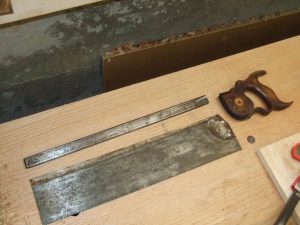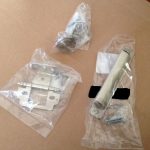We may receive a commission when you use our affiliate links. However, this does not impact our recommendations.
So you’ve decided to try your hand at saw restoration. Congratulations! You’ve got your newly minted copy of “Super-Tune Your Backsaw” but you’ve got no backsaw to super-tune. What to do? Have no worries, my friend, I’ve put together some tips to help you on your way. Dive in and you’ll be one step closer to never turning your table saw on again …
Tip #1. Feed on the bottom
The problem for most novices is not finding a quality saw. The trouble is knowing which saws to buy and which saws to pass up. The trick? Be a bottom feeder. Almost any old backsaw can be tuned to a high degree and made to do fantastic work. Because of this, I recommend you not bother with shiny saw blades, immaculate handles with the original paper label and factory fresh teeth. The old crows will drive these saws into the stratosphere in cost anyway. Plus, in a worst case scenario, if you buy a beat up old saw for $5 and it turns out to be a glorified paint-scraper, then you’ve only lost $5 and learned a whole lot more about hand saw restoration. I’ve never spent more than $20 on any of my user saws. Warped and rusted blades, broken handles, and missing hardware are things that collectors will not bother with … but you should! And the older the saw the better. Look for brass hardware, ornate handles and deep patina. These are the hallmarks of saw greatness.
Tip #2. Don’t buy anything else (yet)
I recommend not buying your saw files, saw set and filing tools until your saw is ready to be filed. The majority of the time and grunt work in hand saw restoration is all about removing rust, re-setting the back, repairing wood and getting everything back together. All of this can be accomplished with stuff you probably already have in your shop – sandpaper, solvents, sledge hammer and scrap blocks of wood. You don’t need to even think about files and sets until you’re in the home stretch. Plus, you’ll need to figure out what size file you need for your saw (and you may not be able to figure that out until after you watch the video). I see lots of students show up to class with every kind of file, set and gadget ever made for saws only to sadly never need them. Don’t buy it until you need it. You can save a lot of time and money.
Tip #3. Upgrades
Thanks to the “21st-Century Hand Tool Renaissance” (as some are calling it) there are now several resources available to budding saw doctors in their quest to resurrect old saws. And unlike full-sized handsaws, anything on an old backsaw can be replaced with better-than-new parts if need be. Saw blades, saw backs, split nuts and new handles can all be upgraded. So go ahead and take a chance on that gorgeous Groves sash saw with the deeply pitted blade. If it proves to be too far gone once you get it cleaned up, you can drop Dom Greco at TGIAG.com a line and order a brand new saw blade that will be better than new. Bent or broken saw back? You can get a custom milled back in brass or sexy bronze from Isaac Smith at BlackburnTools.com. Split nuts? There are now nearly half a dozen makers all available on-line. And last but not least, what about the handle? Well, you are allegedly a woodworker, right? If you have glue and rasps you can fix anything on a handle. And if you want to make a whole new handle for a truly unique work of functional art, then check out my other DVD that walks you step by step through making a custom handle – “Build A Custom Backsaw” also from Popular Woodworking.
Tip #4 Stop reading this post.
Start a hand saw restoration project, and change your world!
–Matt Cianci 🙂
Here are some supplies and tools we find essential in our everyday work around the shop. We may receive a commission from sales referred by our links; however, we have carefully selected these products for their usefulness and quality.











In general, I agree that you can get a lot of vintage saw for a very low price if you’re willing to do the restoration work. And I’m glad you’re working to demystify the process. I started sharpening my own saws after I got one of my saws back from a “professional” sharpening service, took one look at the hack sharpening job, and thought, “okay, I’ve never tried to sharpen a saw before, but I think I can do better than THIS!” I was right. I’ve since restored several rust-bucket saws to working condition.
That said, I have two saws–a big rip saw and a small backsaw, both vintage Disstons–that I paid a tidy sum for. Both were in excellent condition, needing only the teeth touched up. Every time I use them, I feel that I paid a fair price for them.
-Steve S.